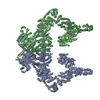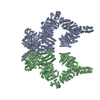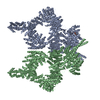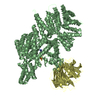+ データを開く
データを開く
- 基本情報
基本情報
| 登録情報 | データベース: PDB / ID: 5np0 | |||||||||
|---|---|---|---|---|---|---|---|---|---|---|
| タイトル | Closed dimer of human ATM (Ataxia telangiectasia mutated) | |||||||||
 要素 要素 | Serine-protein kinase ATM | |||||||||
 キーワード キーワード |  SIGNALING PROTEIN / PIKK / SIGNALING PROTEIN / PIKK /  kinase (キナーゼ) / DNA-repair / HEAT-repeats kinase (キナーゼ) / DNA-repair / HEAT-repeats | |||||||||
| 機能・相同性 |  機能・相同性情報 機能・相同性情報positive regulation of DNA catabolic process / establishment of RNA localization to telomere / positive regulation of telomerase catalytic core complex assembly / cellular response to nitrosative stress / negative regulation of telomere capping / positive regulation of DNA damage response, signal transduction by p53 class mediator / establishment of protein-containing complex localization to telomere / regulation of microglial cell activation / Sensing of DNA Double Strand Breaks / positive regulation of telomere maintenance via telomere lengthening ...positive regulation of DNA catabolic process / establishment of RNA localization to telomere / positive regulation of telomerase catalytic core complex assembly / cellular response to nitrosative stress / negative regulation of telomere capping / positive regulation of DNA damage response, signal transduction by p53 class mediator / establishment of protein-containing complex localization to telomere / regulation of microglial cell activation / Sensing of DNA Double Strand Breaks / positive regulation of telomere maintenance via telomere lengthening / meiotic telomere clustering / lipoprotein catabolic process / pre-B cell allelic exclusion / DNA-dependent protein kinase activity / histone H2AXS139 kinase activity / male meiotic nuclear division / histone mRNA catabolic process / female meiotic nuclear division / regulation of telomere maintenance via telomerase / pexophagy / cellular response to X-ray / peptidyl-serine autophosphorylation /  V(D)J遺伝子再構成 / oocyte development / Impaired BRCA2 binding to PALB2 / reciprocal meiotic recombination / V(D)J遺伝子再構成 / oocyte development / Impaired BRCA2 binding to PALB2 / reciprocal meiotic recombination /  DNA repair complex / Defective homologous recombination repair (HRR) due to BRCA1 loss of function / Defective HDR through Homologous Recombination Repair (HRR) due to PALB2 loss of BRCA1 binding function / Defective HDR through Homologous Recombination Repair (HRR) due to PALB2 loss of BRCA2/RAD51/RAD51C binding function / Homologous DNA Pairing and Strand Exchange / Resolution of D-loop Structures through Synthesis-Dependent Strand Annealing (SDSA) / Resolution of D-loop Structures through Holliday Junction Intermediates / HDR through Single Strand Annealing (SSA) / Impaired BRCA2 binding to RAD51 / 1-phosphatidylinositol-3-kinase activity / response to ionizing radiation / mitotic spindle assembly checkpoint signaling / TP53 Regulates Transcription of Caspase Activators and Caspases / negative regulation of B cell proliferation / mitotic G2 DNA damage checkpoint signaling / Presynaptic phase of homologous DNA pairing and strand exchange / peroxisomal matrix / TP53 Regulates Transcription of Genes Involved in Cytochrome C Release / DNA repair complex / Defective homologous recombination repair (HRR) due to BRCA1 loss of function / Defective HDR through Homologous Recombination Repair (HRR) due to PALB2 loss of BRCA1 binding function / Defective HDR through Homologous Recombination Repair (HRR) due to PALB2 loss of BRCA2/RAD51/RAD51C binding function / Homologous DNA Pairing and Strand Exchange / Resolution of D-loop Structures through Synthesis-Dependent Strand Annealing (SDSA) / Resolution of D-loop Structures through Holliday Junction Intermediates / HDR through Single Strand Annealing (SSA) / Impaired BRCA2 binding to RAD51 / 1-phosphatidylinositol-3-kinase activity / response to ionizing radiation / mitotic spindle assembly checkpoint signaling / TP53 Regulates Transcription of Caspase Activators and Caspases / negative regulation of B cell proliferation / mitotic G2 DNA damage checkpoint signaling / Presynaptic phase of homologous DNA pairing and strand exchange / peroxisomal matrix / TP53 Regulates Transcription of Genes Involved in Cytochrome C Release /  ヘイフリック限界 / positive regulation of cell adhesion / Regulation of HSF1-mediated heat shock response / ヘイフリック限界 / positive regulation of cell adhesion / Regulation of HSF1-mediated heat shock response /  somitogenesis / regulation of cellular response to heat / DNA damage response, signal transduction by p53 class mediator resulting in cell cycle arrest / cellular response to retinoic acid / somitogenesis / regulation of cellular response to heat / DNA damage response, signal transduction by p53 class mediator resulting in cell cycle arrest / cellular response to retinoic acid /  signal transduction in response to DNA damage / ovarian follicle development / negative regulation of TORC1 signaling / positive regulation of telomere maintenance via telomerase / Pexophagy / signal transduction in response to DNA damage / ovarian follicle development / negative regulation of TORC1 signaling / positive regulation of telomere maintenance via telomerase / Pexophagy /  telomere maintenance / post-embryonic development / thymus development / regulation of signal transduction by p53 class mediator / DNA damage checkpoint signaling / telomere maintenance / post-embryonic development / thymus development / regulation of signal transduction by p53 class mediator / DNA damage checkpoint signaling /  regulation of autophagy / determination of adult lifespan / TP53 Regulates Transcription of DNA Repair Genes / Nonhomologous End-Joining (NHEJ) / Stabilization of p53 / double-strand break repair via homologous recombination / Autodegradation of the E3 ubiquitin ligase COP1 / regulation of autophagy / determination of adult lifespan / TP53 Regulates Transcription of DNA Repair Genes / Nonhomologous End-Joining (NHEJ) / Stabilization of p53 / double-strand break repair via homologous recombination / Autodegradation of the E3 ubiquitin ligase COP1 /  brain development / multicellular organism growth / cellular response to gamma radiation / HDR through Homologous Recombination (HRR) / G2/M DNA damage checkpoint / Regulation of TP53 Activity through Methylation / DNA Damage/Telomere Stress Induced Senescence / spindle / brain development / multicellular organism growth / cellular response to gamma radiation / HDR through Homologous Recombination (HRR) / G2/M DNA damage checkpoint / Regulation of TP53 Activity through Methylation / DNA Damage/Telomere Stress Induced Senescence / spindle /  遺伝的組換え / cellular response to reactive oxygen species / double-strand break repair via nonhomologous end joining / positive regulation of neuron apoptotic process / double-strand break repair / intrinsic apoptotic signaling pathway in response to DNA damage / 遺伝的組換え / cellular response to reactive oxygen species / double-strand break repair via nonhomologous end joining / positive regulation of neuron apoptotic process / double-strand break repair / intrinsic apoptotic signaling pathway in response to DNA damage /  細胞老化 / Regulation of TP53 Degradation / Recruitment and ATM-mediated phosphorylation of repair and signaling proteins at DNA double strand breaks / 細胞老化 / Regulation of TP53 Degradation / Recruitment and ATM-mediated phosphorylation of repair and signaling proteins at DNA double strand breaks /  heart development / Processing of DNA double-strand break ends / cytoplasmic vesicle / peptidyl-serine phosphorylation / neuron apoptotic process / regulation of apoptotic process / Regulation of TP53 Activity through Phosphorylation / protein autophosphorylation / response to hypoxia / heart development / Processing of DNA double-strand break ends / cytoplasmic vesicle / peptidyl-serine phosphorylation / neuron apoptotic process / regulation of apoptotic process / Regulation of TP53 Activity through Phosphorylation / protein autophosphorylation / response to hypoxia /  regulation of cell cycle / regulation of cell cycle /  non-specific serine/threonine protein kinase / positive regulation of cell migration / positive regulation of apoptotic process / non-specific serine/threonine protein kinase / positive regulation of cell migration / positive regulation of apoptotic process /  protein phosphorylation / protein serine kinase activity protein phosphorylation / protein serine kinase activity類似検索 - 分子機能 | |||||||||
| 生物種 |   Homo sapiens (ヒト) Homo sapiens (ヒト) | |||||||||
| 手法 |  電子顕微鏡法 / 電子顕微鏡法 /  単粒子再構成法 / 単粒子再構成法 /  クライオ電子顕微鏡法 / 解像度: 5.7 Å クライオ電子顕微鏡法 / 解像度: 5.7 Å | |||||||||
 データ登録者 データ登録者 | Baretic, D. / Pollard, H.K. / Fisher, D.I. / Johnson, C.M. / Santhanam, B. / Truman, C.M. / Kouba, T. / Fersht, A.R. / Phillips, C. / Williams, R.L. | |||||||||
| 資金援助 |  英国, 2件 英国, 2件
| |||||||||
 引用 引用 |  ジャーナル: Sci Adv / 年: 2017 ジャーナル: Sci Adv / 年: 2017タイトル: Structures of closed and open conformations of dimeric human ATM. 著者: Domagoj Baretić / Hannah K Pollard / David I Fisher / Christopher M Johnson / Balaji Santhanam / Caroline M Truman / Tomas Kouba / Alan R Fersht / Christopher Phillips / Roger L Williams /  要旨: ATM (ataxia-telangiectasia mutated) is a phosphatidylinositol 3-kinase-related protein kinase (PIKK) best known for its role in DNA damage response. ATM also functions in oxidative stress response, ...ATM (ataxia-telangiectasia mutated) is a phosphatidylinositol 3-kinase-related protein kinase (PIKK) best known for its role in DNA damage response. ATM also functions in oxidative stress response, insulin signaling, and neurogenesis. Our electron cryomicroscopy (cryo-EM) suggests that human ATM is in a dynamic equilibrium between closed and open dimers. In the closed state, the PIKK regulatory domain blocks the peptide substrate-binding site, suggesting that this conformation may represent an inactive or basally active enzyme. The active site is held in this closed conformation by interaction with a long helical hairpin in the TRD3 (tetratricopeptide repeats domain 3) domain of the symmetry-related molecule. The open dimer has two protomers with only a limited contact interface, and it lacks the intermolecular interactions that block the peptide-binding site in the closed dimer. This suggests that the open conformation may be more active. The ATM structure shows the detailed topology of the regulator-interacting N-terminal helical solenoid. The ATM conformational dynamics shown by the structures represent an important step in understanding the enzyme regulation. | |||||||||
| 履歴 |
|
- 構造の表示
構造の表示
| ムービー |
 ムービービューア ムービービューア |
|---|---|
| 構造ビューア | 分子:  Molmil Molmil Jmol/JSmol Jmol/JSmol |
- ダウンロードとリンク
ダウンロードとリンク
- ダウンロード
ダウンロード
| PDBx/mmCIF形式 |  5np0.cif.gz 5np0.cif.gz | 735.5 KB | 表示 |  PDBx/mmCIF形式 PDBx/mmCIF形式 |
|---|---|---|---|---|
| PDB形式 |  pdb5np0.ent.gz pdb5np0.ent.gz | 503.4 KB | 表示 |  PDB形式 PDB形式 |
| PDBx/mmJSON形式 |  5np0.json.gz 5np0.json.gz | ツリー表示 |  PDBx/mmJSON形式 PDBx/mmJSON形式 | |
| その他 |  その他のダウンロード その他のダウンロード |
-検証レポート
| アーカイブディレクトリ |  https://data.pdbj.org/pub/pdb/validation_reports/np/5np0 https://data.pdbj.org/pub/pdb/validation_reports/np/5np0 ftp://data.pdbj.org/pub/pdb/validation_reports/np/5np0 ftp://data.pdbj.org/pub/pdb/validation_reports/np/5np0 | HTTPS FTP |
|---|
-関連構造データ
- リンク
リンク
- 集合体
集合体
| 登録構造単位 | 
|
|---|---|
| 1 |
|
- 要素
要素
| #1: タンパク質 | 分子量: 352393.969 Da / 分子数: 2 / 由来タイプ: 組換発現 / 由来: (組換発現)   Homo sapiens (ヒト) / 細胞株: HEK293F / 遺伝子: ATM / プラスミド: pDEST12.2-OriP / 細胞株 (発現宿主): HEK293F / 発現宿主: Homo sapiens (ヒト) / 細胞株: HEK293F / 遺伝子: ATM / プラスミド: pDEST12.2-OriP / 細胞株 (発現宿主): HEK293F / 発現宿主:   Homo sapiens (ヒト) Homo sapiens (ヒト)参照: UniProt: Q13315,  non-specific serine/threonine protein kinase non-specific serine/threonine protein kinase |
|---|
-実験情報
-実験
| 実験 | 手法:  電子顕微鏡法 電子顕微鏡法 |
|---|---|
| EM実験 | 試料の集合状態: PARTICLE / 3次元再構成法:  単粒子再構成法 単粒子再構成法 |
- 試料調製
試料調製
| 構成要素 | 名称: Dimeric human ATM (Ataxia telangiectasia mutated) kinase タイプ: ORGANELLE OR CELLULAR COMPONENT / 詳細: homodimer / Entity ID: all / 由来: RECOMBINANT | ||||||||||||||||||||||||||||||
|---|---|---|---|---|---|---|---|---|---|---|---|---|---|---|---|---|---|---|---|---|---|---|---|---|---|---|---|---|---|---|---|
| 分子量 | 値: 0.705 MDa / 実験値: YES | ||||||||||||||||||||||||||||||
| 由来(天然) | 生物種:   Homo sapiens (ヒト) Homo sapiens (ヒト) | ||||||||||||||||||||||||||||||
| 由来(組換発現) | 生物種:   Homo sapiens (ヒト) / 細胞: HEK293 / プラスミド Homo sapiens (ヒト) / 細胞: HEK293 / プラスミド : pDEST12.2-OriP : pDEST12.2-OriP | ||||||||||||||||||||||||||||||
| 緩衝液 | pH: 8 | ||||||||||||||||||||||||||||||
| 緩衝液成分 |
| ||||||||||||||||||||||||||||||
| 試料 | 濃度: 0.6 mg/ml / 包埋: NO / シャドウイング: NO / 染色 : NO / 凍結 : NO / 凍結 : YES : YES詳細: N-terminally FLAG-tagged ATM kinase was purified by affinity chromatography (anti-FLAG), overnight dialysis and gel-filtration. The sample was flash-frozen in liquid nitrogen until used for cryo-EM. | ||||||||||||||||||||||||||||||
| 試料支持 |
| ||||||||||||||||||||||||||||||
急速凍結 | 装置: HOMEMADE PLUNGER / 凍結剤: ETHANE / 湿度: 100 % / 凍結前の試料温度: 277.15 K / 詳細: 3 uL of sample/grid blotted for 12 s |
- 電子顕微鏡撮影
電子顕微鏡撮影
| 実験機器 |  モデル: Titan Krios / 画像提供: FEI Company |
|---|---|
| 顕微鏡 | モデル: FEI TITAN KRIOS |
| 電子銃 | 電子線源 : :  FIELD EMISSION GUN / 加速電圧: 300 kV / 照射モード: FLOOD BEAM FIELD EMISSION GUN / 加速電圧: 300 kV / 照射モード: FLOOD BEAM |
| 電子レンズ | モード: BRIGHT FIELD Bright-field microscopy / 倍率(公称値): 97902 X / 倍率(補正後): 35714 X / 最大 デフォーカス(公称値): 4000 nm / 最小 デフォーカス(公称値): 2500 nm / Cs Bright-field microscopy / 倍率(公称値): 97902 X / 倍率(補正後): 35714 X / 最大 デフォーカス(公称値): 4000 nm / 最小 デフォーカス(公称値): 2500 nm / Cs : 2.7 mm / C2レンズ絞り径: 70 µm / アライメント法: COMA FREE : 2.7 mm / C2レンズ絞り径: 70 µm / アライメント法: COMA FREE |
| 試料ホルダ | 凍結剤: NITROGEN 試料ホルダーモデル: FEI TITAN KRIOS AUTOGRID HOLDER 最低温度: 80.15 K |
| 撮影 | 平均露光時間: 0.8 sec. / 電子線照射量: 2.1 e/Å2 / 検出モード: SUPER-RESOLUTION フィルム・検出器のモデル: GATAN K2 SUMMIT (4k x 4k) 撮影したグリッド数: 4 / 実像数: 2720 |
| 電子光学装置 | エネルギーフィルター名称 : GIF / エネルギーフィルター 上限: 20 eV / エネルギーフィルター 下限: 0 eV : GIF / エネルギーフィルター 上限: 20 eV / エネルギーフィルター 下限: 0 eV |
| 画像スキャン | 動画フレーム数/画像: 20 / 利用したフレーム数/画像: 1-20 |
- 解析
解析
| ソフトウェア | 名称: PHENIX / バージョン: 1.10.1_2155: / 分類: 精密化 | ||||||||||||||||||||||||||||||||||||||||||||||||||
|---|---|---|---|---|---|---|---|---|---|---|---|---|---|---|---|---|---|---|---|---|---|---|---|---|---|---|---|---|---|---|---|---|---|---|---|---|---|---|---|---|---|---|---|---|---|---|---|---|---|---|---|
| EMソフトウェア |
| ||||||||||||||||||||||||||||||||||||||||||||||||||
CTF補正 | タイプ: PHASE FLIPPING ONLY | ||||||||||||||||||||||||||||||||||||||||||||||||||
| 粒子像の選択 | 選択した粒子像数: 371671 | ||||||||||||||||||||||||||||||||||||||||||||||||||
| 対称性 | 点対称性 : C1 (非対称) : C1 (非対称) | ||||||||||||||||||||||||||||||||||||||||||||||||||
3次元再構成 | 解像度: 5.7 Å / 解像度の算出法: FSC 0.143 CUT-OFF / 粒子像の数: 25315 / クラス平均像の数: 1 / 対称性のタイプ: POINT | ||||||||||||||||||||||||||||||||||||||||||||||||||
| 原子モデル構築 | 空間: REAL | ||||||||||||||||||||||||||||||||||||||||||||||||||
| 原子モデル構築 | PDB-ID: 4JSP 詳細: building de novo the structure of ATM N-solenoid and modelling of the ATM FATKIN (using mTOR FATKIN PDB:4JSP) | ||||||||||||||||||||||||||||||||||||||||||||||||||
| 拘束条件 |
|
 ムービー
ムービー コントローラー
コントローラー
















 PDBj
PDBj


















